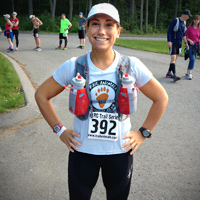

Meet an experienced marathoner who said that running eases the pain of her rheumatoid arthritis and gives her a priceless feeling of accomplishment.

Once morbidly obese, rheumatoid arthritis patient Colleen Murphy, 30, laces up her Asics and prepares to run 10, 20, 50, or 100 miles, as the mood strikes.
While people might not think “marathon” when they think of rheumatoid arthritis and exercise, Murphy’s journey to fitness with rheumatoid arthritis led her to a 100-mile ultramarathon. She's found that running and cross-training (she rows and swims as well) help her manage her RA pain far better than being out of shape.
I've had arthritis since I was a child. We finally figured out it was RA about six years ago,” said Murphy. At that time, she said she weighed 270 pounds. I never really exercised or did anything. I took Celebrex twice a day,” she recalled. At a certain point, she’d had enough. She started losing weight, cut the Celebrex down to once a day, and then, as she switched to a healthier diet and began running, went off the daily medications entirely.
“I do manage symptoms with ibuprofen when I get a flare-up,” said Murphy. Her RA symptoms primarily affect her hands — “they will swell to the point where I can’t use them,” she said — and occasionally her hips and ankles as well.
To people with rheumatoid arthritis (or not) who think a marathon is out of reach, Murphy said, “If you had told me back then that I would one day run a 5K, I’d have laughed at you.”
But then she completed a couch-to-5K training program and ran a 5K. And then a 10K. And then seven half-marathons.
“I got hooked. Then I ran my first marathon, the Philadelphia marathon, in November 2011,” she recalled. Her marathon personal record is 3:31, and she has qualified for the Boston Marathon, a prestigious goal for marathoners. After that, she pushed herself a bit further, found that trail running is actually easier on her joints, and ended up competing in the 100-mile ultramarathon.
Allowing plenty of training time is essential, according to rheumatologist Christie M. Bartels, MD, a rheumatologist on the faculty at the University of Wisconsin School of Medicine and Public Health in Madison. “Start with shorter runs and allow a more prolonged training schedule,” recommended Dr. Bartels. Like Murphy does, Bartels suggested cross-training as a way to ease the ongoing pressure on your joints.
Murphy uses the Jeff Galloway method, a specific approach to marathon preparation. She gave herself plenty of time — a full year — to train for her first marathon. Even now, with her running experience, she still takes a structured but forgiving approach to preparing for a race, using the weeks before a race to build up her distance gradually and then allow a week at least afterwards to ramp down again. And if she wakes up stiff and sore or uninspired on cold winter mornings, she’ll give herself a break on training, at least for part of the day.
“I tell myself, if I don’t feel up to it right now, maybe I will later in the day,” she reported. Often she finds that by the end of the day, she is feeling more like going the distance. Overall, she’s reaped the benefits of exercise with rheumatoid arthritis. “Exercise keeps my muscles loose and it keeps my joints working. I feel better. Sometimes you have to change your plan a little bit to adjust for your life, but I never have allowed it to stop me.”
A diagnosis of rheumatoid arthritis certainly doesn’t have to exclude you from the marathon club. But you have to be smart about whether it’s right for you. Checking in with your rheumatologist is essential, said Dr. Bartels.
“If you have a really well controlled disease and no history of deformity of feet, ankle, or knees, you could train,” she said. Taking medications for rheumatoid arthritis shouldn’t prevent you from running long distances either, although it’s important to remember to use sunscreen, stay hydrated, and do your best to avoid infection, since both long distance running and RA medications can lower your immunity.
Once you begin training and competing, Bartels said, “Let pain be your guide.” Even though competitive athletes have a somewhat heroic view of pain, people with rheumatoid arthritis need to take a break when they feel sore or swollen. That's not to say that you should keep exercise gentle and low-key. Training for a marathon can be challenging, and that’s okay.
“Vigorous activity of high intensity can be well tolerated,” said sports medicine expert Audrey Lynn Millar, PT, PhD, professor in the department of physical therapy at the School of Health Sciences of Winston-Salem State University in Winston-Salem, N.C., and spokesperson for the American College of Sports Medicine. And, she said, research has confirmed what Murphy reported, that high intensity exercise can reduce symptoms. Still, like Bartels, she advocated keeping careful track of symptoms during training, so you can identify patterns early.
Above all, stay safe in training and competing. Murphy, who blogs about running at Bee Fit, prefers to go for trail runs with her trail running group, but if she’s running alone, she avoids running at night, carries pepper spray, and always lets her family know where she’s running and when she should be home.
If you’re even the smallest bit tempted to try training for a marathon, go for it. “It’s the experience of a lifetime. I don’t know of any runners with RA, but I wish there were more,” said Murphy.
Copyright © www.orthopaedics.win Bone Health All Rights Reserved